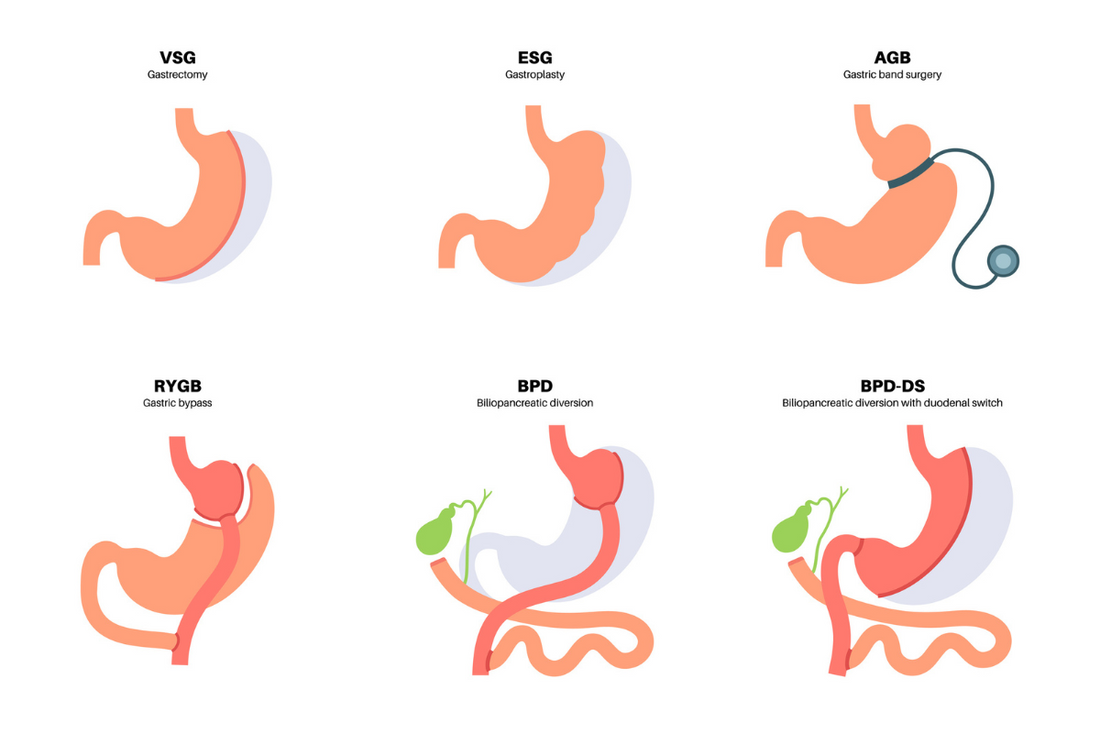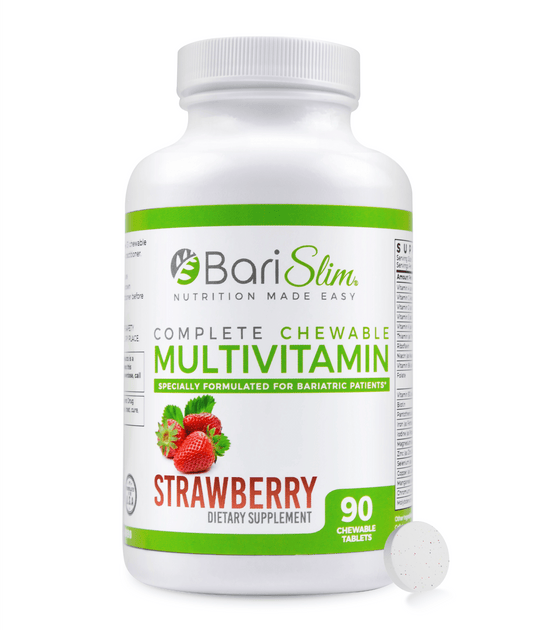Table of Contents
- 9 Types of Weight Loss Surgery
- Adjustable Gastric Band (AGB)
- Gastric Sleeve Surgery: Vertical Sleeve Gastrectomy (VSG)
- Gastric Balloon Surgery
- Endoscopic Sleeve Gastroplasty (ESG)
- Gastric Bypass Surgery: Roux-en-Y Gastric Bypass (RYGB)
- Biliopancreatic Diversion (BPD)
- Biliopancreatic Diversion with Duodenal Switch (BPD-DS)
- Stomach Intestinal Pylorus Sparing Surgery (SIPS)
- Single Anastomosis Duodeno-Ileal Bypass with Sleeve Gastrectomy (SADI-S)
- What Weight Loss Surgery is Most Effective?
- What is the Safest Surgery for Weight Loss?
In the journey to achieve a healthier lifestyle, you may consider weight loss surgery as an option to help reach your goals. There are different types of weight loss surgery, each with its own advantages and potential drawbacks. To help you make an informed decision, it is essential to understand the various procedures available and the criteria for selecting the most suitable one for your specific needs.
Weight loss surgeries, also known as bariatric procedures, work by limiting food intake, altering the digestion process, or a combination of both. The main surgical options include gastric bypass, gastric sleeve, and adjustable gastric banding, each with distinct methods for promoting weight loss. Outcomes may vary depending on your medical history, lifestyle, and commitment to post-surgery care.
As you contemplate these options, consult with a qualified healthcare professional to explore the potential benefits and risks involved. By understanding the different types of weight loss surgery and their implications, you are better equipped to choose the most suitable procedure and embark on a successful weight loss journey.
9 Types of Weight Loss Surgery

Adjustable Gastric Band (AGB)
The Adjustable Gastric Band (AGB) is a weight loss surgery that involves placing an inflatable band made of silicone toward the upper end of your stomach. This creates a small stomach pouch that limits the food intake, hence promoting weight loss. Your surgeon can adjust the band's tightness to control the speed of weight loss and avoid complications.
Gastric Sleeve Surgery: Vertical Sleeve Gastrectomy (VSG)
In Gastric Sleeve Surgery or Vertical Sleeve Gastrectomy (VSG), your surgeon removes around 80% of your stomach, leaving a narrow, sleeve-shaped tube. This not only reduces the stomach's capacity but also affects hormones related to hunger and appetite, resulting in significant weight loss.
Gastric Balloon Surgery
Gastric Balloon Surgery is a minimally invasive procedure that involves placing a deflated balloon into your stomach through a small incision. The balloon is then inflated with a saline solution, occupying space in your stomach and helping you feel full with less food consumed.
Endoscopic Sleeve Gastroplasty (ESG)
Endoscopic Sleeve Gastroplasty (ESG) is a less invasive procedure in which the surgeon uses an endoscope to create a sleeve inside your stomach by stitching the stomach walls. The reduced stomach size limits food intake and helps achieve weight loss goals.
Gastric Bypass Surgery: Roux-en-Y Gastric Bypass (RYGB)
Roux-en-Y Gastric Bypass (RYGB) surgery involves creating a small stomach pouch and connecting it directly to the middle part of your small intestine, bypassing the first part (duodenum). This modifies your digestive system and helps you lose weight by limiting food intake and reducing nutrient absorption.
Biliopancreatic Diversion (BPD)
Biliopancreatic Diversion (BPD) is a weight loss surgery that combines the principles of both Gastric Sleeve Surgery and Gastric Bypass Surgery. Your surgeon removes a portion of your stomach, similar to a sleeve gastrectomy, and then reroutes your small intestine, bypassing the duodenum and the first part of the small intestine. This procedure is less common due to its higher risk of complications.
Biliopancreatic Diversion with Duodenal Switch (BPD-DS)
Biliopancreatic Diversion with Duodenal Switch (BPD-DS) involves performing the Biliopancreatic Diversion procedure, but preserves the duodenum (first part of the small intestine) to minimize nutrient malabsorption. It offers significant weight loss results by combining both restrictive and malabsorptive techniques.
Stomach Intestinal Pylorus Sparing Surgery (SIPS)
Stomach Intestinal Pylorus Sparing Surgery (SIPS) is a modified version of the duodenal switch. Your surgeon creates a gastric sleeve and then reroutes a longer portion of your small intestine, sparing the stomach's pyloric valve. This procedure helps maintain adequate nutrient absorption while promoting weight loss.
Single Anastomosis Duodeno-Ileal Bypass with Sleeve Gastrectomy (SADI-S)
The Single Anastomosis Duodeno-Ileal Bypass with Sleeve Gastrectomy (SADI-S) is a combination of sleeve gastrectomy and intestinal bypass. Your surgeon performs a sleeve gastrectomy and then connects your duodenum to the lower part of your small intestine (ileum). This results in reduced food intake and lower nutrient absorption, leading to significant weight loss.
What Weight Loss Surgery is Most Effective?

When it comes to weight loss surgery, several options are available, each with its own benefits and drawbacks. The effectiveness of a given procedure depends on your individual needs and circumstances. Here, we outline some of the most common weight loss surgeries and their effectiveness.
Roux-en-Y Gastric Bypass (RYGB) is considered one of the most effective weight loss surgeries. During this procedure, a small pouch is created from the stomach while bypassing a part of the small intestine. As a result, you consume less food, and your body absorbs fewer calories. Many patients experience significant weight loss and improvements in their health after RYGB. However, this surgery requires strict lifestyle changes. It may cause "dumping syndrome," a condition where food passes too quickly through the digestive system, leading to various symptoms like nausea, dizziness, and weakness.
Sleeve Gastrectomy is another effective option for weight loss. During this procedure, a significant portion of the stomach is removed, leaving a smaller, tubular-shaped stomach. The reduced stomach size limits the amount of food you can consume, while hormonal changes reduce hunger. On average, patients can expect to lose 60-70% of their excess body weight within the first year after the surgery. However, this procedure is irreversible, and long-term vitamin deficiencies are possible.
Adjustable Gastric Banding involves placing a silicone band around the upper part of the stomach, creating a small pouch. This small pouch is intended to limit the intake of food. The band is adjustable, allowing for more or less restriction as needed. Although this surgery is less invasive and has fewer complications, the weight loss is typically slower and less significant than with gastric bypass or sleeve gastrectomy. On average, patients lose around 40-50% of their excess body weight within the first year.
Biliopancreatic Diversion with Duodenal Switch (BPD-DS) is a complex surgery that combines elements of gastric bypass and sleeve gastrectomy. A portion of the stomach is removed, and most of the small intestine is bypassed. This procedure leads to impressive weight loss, with patients losing up to 70% of their excess body weight within the first year. Additionally, BPD-DS is often effective in resolving obesity-related health issues, such as type 2 diabetes. However, this surgery carries a higher risk of complications and requires stringent lifelong nutritional supplementation and follow-up.
Ultimately, the most effective weight loss surgery for you depends on your individual circumstances, such as your BMI (body mass index), health conditions, and weight loss goals. It's essential to have a thorough discussion with your healthcare provider to determine the best option for your unique situation.
What is the Safest Surgery for Weight Loss?

When considering weight loss surgeries, it is essential to determine the safest and most effective option for your health. Three common weight loss surgeries are gastric bypass, gastric sleeve, and gastric balloon. Each has its risks and benefits, but some factors contribute to a safer procedure with fewer complications.
Gastric Bypass
Also known as Roux-en-Y gastric bypass, this is a highly effective and commonly performed weight loss surgery. The surgeon modifies your stomach and small intestine, thus reducing the amount of food you can consume and the nutrients your body can absorb. While gastric bypass has a long-term success rate and can lead to major improvements in obesity-related issues such as diabetes, heart disease, and sleep apnea, it may come with some potential complications. These can include infection, blood clots, and ulcers. Additionally, you may experience some minor side effects like nausea and hypoglycemia.
Gastric Sleeve
This procedure involves removing a portion of your stomach and creating a smaller, tube-shaped pouch. As a result, you will consume less food, leading to weight loss. Gastric sleeve is considered by the American Society for Metabolic and Bariatric Surgery as a safe and effective option, especially for patients with severe obesity. However, it can still pose some risks, such as leakage, infection, and blood clots.
Gastric Balloon
Gastric balloons are typically a temporary solution that can help jump-start weight loss and encourage healthier eating habits. It is the least invasive of the three procedures and can often be performed using a small camera called an endoscope. While it has a lower risk of complications compared to other surgeries, some side effects can still occur, including nausea, vomiting, and diarrhea.
To determine the safest surgery for your weight loss journey, consult with a knowledgeable and experienced surgeon who can guide you through the process. They will assess your medical history, weight, and factors contributing to obesity, such as high blood pressure or metabolic syndrome, before recommending the most suitable option. Remember, safety and long-term success are paramount in achieving your weight loss goals and improving your overall health.
Also Read: Best Surgical Procedure for Weight Loss: Complete Guide



 Order Free Sample
Order Free Sample





